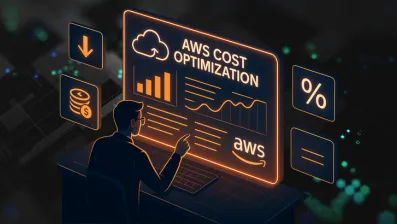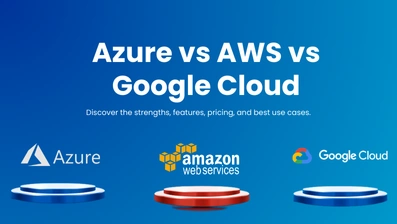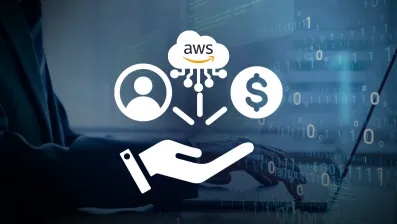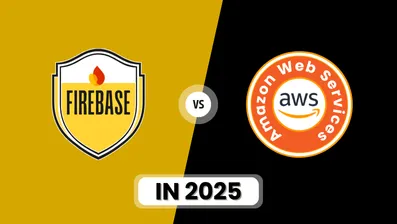Amazon Web Services (AWS) is the world’s most comprehensive and widely adopted cloud platform, and in 2025, its dominance shows no signs of slowing down.
With a relentless focus on innovation, AWS powers millions of businesses across the globe, from nimble startups to Fortune 500 giants.
But what exactly makes AWS the go-to choice for cloud computing?
It’s the unmatched breadth and depth of AWS cloud services, ranging from compute and storage to artificial intelligence and analytics, that allows businesses to build faster, scale efficiently, and reduce operational complexity.
With over 200 fully featured services and growing, it’s easy to get overwhelmed. That’s why we’ve compiled a list of the top 20 AWS services for 2025. These tools aren’t just popular; they're reshaping the way modern businesses operate, innovate, and grow.
Be it planning your first AWS deployment or expanding your cloud footprint, this guide offers clarity on which services deserve your attention this year.
What Are AWS Services?
AWS services are a comprehensive set of cloud-based tools and solutions offered by Amazon Web Services, designed to help businesses build, deploy, and manage applications at scale.
From computing power and storage to artificial intelligence, machine learning, and security, AWS cloud services provide the infrastructure needed to support virtually every type of digital workload.
In simple terms, AWS services act as on-demand building blocks, allowing you to rent computing resources instead of owning and managing physical hardware.
Whether you're launching a startup or running a global enterprise, AWS enables you to innovate faster, reduce operational costs, and scale globally with ease.
These services are categorized across multiple domains to suit different needs, forming the foundation of modern AWS services and enabling businesses to build secure, scalable, and innovative cloud solutions.
Categories of AWS Cloud Services:
- Compute: EC2, Lambda, Fargate
Storage: S3, Glacier, EBS
Database: RDS, DynamoDB, Redshift
Networking: VPC, Route 53, CloudFront
Machine Learning: SageMaker, Bedrock
DevOps: CodePipeline, CloudWatch, Step Functions
Security: IAM, KMS, AWS WAF
Let’s explore more about them in detail.
Before diving into the top AWS services to watch in 2025, it's important to understand how we curated this list.
With the vast number of AWS cloud services available today, including compute, storage, AI, and developer tools, it’s crucial to highlight those that offer the most value in terms of innovation, scalability, and impact.
How We Selected the Top 20 AWS Services
With hundreds of services available, it’s important to focus on the most impactful ones. Our selection is based on a blend of:
Evaluation Criteria
Popularity and Widespread Adoption: We selected AWS services that are widely trusted across industries and regularly appear in modern cloud architectures powered by AWS cloud services.
Relevance to Emerging Tech Trends: Priority was given to AWS services that align with key 2025 trends like AI, edge computing, serverless, and sustainability.
Versatility and Scalability: Each AWS service listed supports a range of use cases, offering scalable solutions for startups and enterprises alike.
Performance Improvements and New Features: We looked for AWS services that received major updates or optimizations in the past year to stay future-ready.
Developer and Enterprise Use Cases: Services that balance developer flexibility and enterprise-grade reliability, including integrations with Microsoft AWS services, were prioritized. Tools that bridge both developer agility and enterprise-grade requirements were given extra weight.
Whether you're adopting AWS cloud services for the first time or optimizing Microsoft AWS services in a hybrid environment, this curated list helps identify what truly matters in 2025.
Top 20 AWS Services to Watch in 2025
Choosing the right AWS services can have a huge impact on your business outcomes—whether you're improving performance, cutting costs, or launching new innovations.
In 2025, the cloud ecosystem is more competitive than ever, and Amazon Web Services continues to set the standard with an unmatched lineup of cloud-native solutions.
These top AWS services are recognized not just for their popularity but also for their ability to scale, integrate, and innovate. From compute and storage to AI and DevOps, each tool listed here plays a strategic role in modern cloud infrastructure.
Whether you're building a startup from scratch or optimizing complex enterprise architectures, this guide to the best AWS cloud services in 2025 will help you stay competitive.
Let’s explore the top 20 in detail—with key benefits, features, use cases, and who they’re ideal for—making this the ultimate resource for evaluating Microsoft AWS services and beyond.
1. Amazon EC2 (Elastic Compute Cloud)
Amazon EC2 is one of the most essential AWS services, delivering secure, resizable compute capacity in the cloud. It allows users to deploy virtual machines (instances) tailored to their specific workload, ensuring optimal performance and cost-efficiency.
Key Benefits: On-demand scalability, deep OS and instance customization, integration with other AWS cloud services.
Key Features: Auto-scaling, EC2 Auto Recovery, placement groups, dedicated hosts.
Use Cases: Web app hosting, batch processing, financial modeling, high-performance computing.
Ideal For: Enterprises and developers who need flexible compute environments within their AWS services stack or hybrid setups with Microsoft AWS services.
2. AWS Lambda
AWS Lambda is a cornerstone of serverless computing within AWS cloud services. It allows developers to run code in response to events without provisioning or managing servers, ensuring quick deployment and scalability.
AWS Lambda is often compared to other serverless platforms, especially for mobile or real-time apps.
For instance, developers often weigh Firebase vs AWS when deciding between managed backend services, especially for MVPs or cross-platform mobile apps.
Key Benefits: Hands-free infrastructure management, event-driven architecture, cost-efficiency through per-invocation billing.
Key Features: Native integration with S3, DynamoDB, and API Gateway; version control; concurrency controls.
Use Cases: Real-time file and image processing, API gateways, data stream handling, backend automation.
Ideal For: Developers, startups, and DevOps teams building reactive applications using modern AWS services and Microsoft AWS services integrations.
3. Amazon S3 (Simple Storage Service)
Amazon S3 remains one of the top AWS cloud services, offering industry-leading durability, availability, and performance for object storage. It supports petabytes of data and is widely adopted for its flexibility and strong integration with the AWS ecosystem.
Key Benefits: 11 9's durability, storage class tiers, lifecycle rules, and built-in security features.
Key Features: S3 Glacier for archiving, cross-region replication, encryption at rest, and in transit.
Use Cases: Data backup, disaster recovery, application assets, big data analytics.
Ideal For: Any organization seeking highly available, cost-effective storage as part of their AWS or Microsoft AWS services strategy.
4. Amazon RDS (Relational Database Service)
Amazon RDS is a fully managed relational database service that simplifies the setup, operation, and scaling of databases in the cloud. It supports popular database engines like MySQL, PostgreSQL, Oracle, and SQL Server, making it one of the most flexible AWS services available for structured data management.
Key Benefits: Automated backups, patching, scaling, and failover reduce operational overhead and enhance reliability.
Key Features: Multi-AZ deployments, read replicas, encryption at rest, and performance insights.
Use Cases: SaaS application backends, content management systems, and enterprise reporting systems.
Ideal For: Developers and IT teams who want fully managed, scalable, and secure relational databases as part of their AWS cloud services architecture or hybrid Microsoft AWS services deployment.
5. Amazon DynamoDB
Amazon DynamoDB is a fast, flexible NoSQL database service built for high-performance applications that require consistent, single-digit millisecond latency at any scale. It’s a serverless database that automatically scales up and down based on traffic.
Key Benefits: Millisecond read/write speeds, no servers to manage, built-in security and backup, pay-per-request pricing.
Key Features: On-demand and provisioned capacity modes, global tables for multi-region replication, DAX for caching.
Use Cases: Real-time bidding systems, e-commerce shopping carts, gaming leaderboards, mobile and IoT apps.
Ideal For: Teams needing ultra-low-latency access to structured data within scalable AWS or Microsoft AWS services environments..
6. Amazon ECS/EKS
Amazon ECS (Elastic Container Service) and EKS (Elastic Kubernetes Service) are powerful container orchestration services from AWS. ECS integrates natively with AWS services, while EKS supports Kubernetes workloads, offering flexibility for running containerized applications at scale.
Key Benefits: Managed infrastructure, integration with AWS developer tools, improved security.
Key Features: Auto-scaling, IAM integration, service discovery, AWS Fargate compatibility.
Use Cases: CI/CD pipelines, microservices architecture, multi-cloud container management.
Ideal For: DevOps teams transitioning to containerized environments using modern AWS services or hybrid Microsoft AWS services setups.
7. Amazon SageMaker
Amazon SageMaker is a fully managed machine learning service that simplifies the process of building, training, and deploying ML models at scale. It’s a central hub for MLOps workflows and AI innovation within AWS cloud services.
Key Benefits: Accelerates model development, reduces manual tuning, built-in deployment capabilities.
Key Features: SageMaker Studio, pipelines, feature store, and model monitor.
Use Cases: Predictive analytics, fraud detection, recommendation engines, AI chatbots.
Ideal For: Data scientists and AI engineers looking to streamline ML workflows within secure, scalable AWS or Microsoft AWS services environments.
8. AWS Fargate
AWS Fargate is a serverless container compute engine that works with both ECS and EKS. It removes the need to provision, scale, or manage servers, allowing you to run containers with ease.
Key Benefits: No infrastructure management, auto-scaling, and granular billing.
Key Features: Seamless ECS/EKS integration, IAM roles for tasks, CloudWatch monitoring.
Use Cases: Event-driven services, stateless applications, secure container environments.
Ideal For: Teams deploying container-based applications rapidly with AWS cloud services or Microsoft AWS services integration.
9. Amazon CloudFront
Amazon CloudFront is AWS’s global content delivery network (CDN), designed to deliver content with low latency and high transfer speed. It securely distributes static and dynamic content to users across the globe.
Key Benefits: Enhanced performance, global reach, built-in DDoS protection.
Key Features: Edge caching, SSL support, custom error responses, Lambda@Edge.
Use Cases: Video streaming, SaaS front-ends, large-scale app distribution.
Ideal For: Companies needing fast and secure content delivery through AWS services or Microsoft AWS services hybrid models.
10. AWS IAM (Identity and Access Management)
AWS IAM is a security-focused service that helps manage access to AWS resources. It enables you to create and enforce user roles and policies with fine-grained permissions.
Key Benefits: Centralized access control, compliance support, secure credential management.
Key Features: MFA support, policy simulation, access analyzer, federated identities.
Use Cases: User access control, enterprise security policies, and regulatory compliance.
Ideal For: Any organization requiring secure user and service access in AWS services or integrated Microsoft AWS services deployments.
11. Amazon VPC (Virtual Private Cloud)
Amazon VPC allows you to provision a logically isolated section of the AWS cloud where you can launch AWS resources in a virtual network that you define. It offers complete control over your networking environment, including IP address ranges, subnets, route tables, and gateways.
Key Benefits: Enhanced network isolation, customizable routing, and private connectivity options.
Key Features: Subnet segmentation, NAT gateways, VPC peering, AWS PrivateLink.
Use Cases: Secure web hosting, PCI-compliant workloads, hybrid connectivity with on-premises infrastructure.
Ideal For: Organizations with strict compliance requirements leveraging AWS services or integrating Microsoft AWS services for hybrid environments..
12. Amazon CloudWatch
Amazon CloudWatch provides monitoring and observability for AWS cloud services and resources. It collects metrics, logs, and events, offering real-time visibility into your cloud environment’s performance.
Key Benefits: Proactive alerting, root cause analysis, cost tracking, and visual dashboards.
Key Features: Custom metrics, anomaly detection, cross-account observability, Lambda insights.
Use Cases: Application monitoring, infrastructure health checks, performance tuning.
Ideal For: DevOps teams and IT administrators looking to optimize AWS services and Microsoft AWS services operations..
13. AWS Glue
AWS Glue is a fully managed ETL (extract, transform, load) service that makes it easy to prepare and transform data for analytics. It automates much of the heavy lifting associated with data integration and preparation.
Key Benefits: Serverless, auto-scalable, minimal configuration, code-free interface.
Key Features: Glue Data Catalog, Glue Studio, crawlers, and job monitoring.
Use Cases: Data lake management, real-time ETL, business intelligence reporting.
Ideal For: BI analysts and data engineers working within AWS cloud services or Microsoft AWS services data pipelines..
14. Amazon Redshift
Amazon Redshift is a fully managed, petabyte-scale data warehouse solution in the AWS cloud. It enables you to run complex SQL queries and get quick insights across structured and semi-structured data.
Key Benefits: High performance, seamless integration with BI tools, and real-time analytics.
Key Features: Redshift Spectrum, concurrency scaling, data sharing, columnar storage.
Use Cases: Customer analytics, reporting dashboards, and large-scale business intelligence.
Ideal For: Data-driven enterprises using AWS services or Microsoft AWS services for analytics at scale..
15. AWS Step Functions
AWS Step Functions is a serverless orchestration service that allows you to build and coordinate distributed applications using visual workflows. It simplifies complex application logic and integrates with a wide range of AWS services.
Key Benefits: Visual development, built-in retries, error handling, seamless service coordination.
Key Features: Workflow Studio, parallel execution, integration with Lambda, ECS, and Glue.
Use Cases: Microservices orchestration, automation of serverless workflows, backend data processing.
Ideal For: Developers and architects designing resilient and auditable workflows across AWS cloud services and Microsoft AWS services..
16. AWS App Runner
AWS App Runner is a fully managed service that makes it easy to build, deploy, and run containerized web applications and APIs at scale without needing deep infrastructure knowledge.
Key Benefits: No servers to manage, automatic scaling, secure deployments.
Key Features: GitHub and ECR integration, HTTPS support, auto-deploy pipelines.
Use Cases: Deploying microservices, web apps, and API backends from source code.
Ideal For: Developers and startups looking for a fast go-to-market solution using AWS services or extending Microsoft AWS services with minimal DevOps overhead.
17. Amazon Route 53
Amazon Route 53 is a scalable and highly available Domain Name System (DNS) web service that connects user requests to infrastructure running in AWS. It supports domain registration and DNS routing for fast, reliable web application performance.
Key Benefits: High availability, DNS failover, seamless routing controls.
Key Features: Geo-routing, traffic flow policies, domain registration, health checks.
Use Cases: Multi-region DNS failover, latency-based routing, SaaS application availability.
Ideal For: Organizations requiring reliable DNS for AWS cloud services or businesses using hybrid Microsoft and AWS services.
18. AWS CodePipeline
AWS CodePipeline is a fully managed continuous integration and delivery service that automates your build, test, and deployment processes for fast and reliable application and infrastructure updates.
Key Benefits: End-to-end automation, faster release cycles, integration with popular tools.
Key Features: GitHub integration, cross-account actions, multi-environment stages.
Use Cases: CI/CD workflows for microservices, container deployments, and infrastructure-as-code.
Ideal For: Agile and DevOps teams building modern apps using AWS services or maintaining pipelines with Microsoft AWS services integration.
19. Amazon Kinesis
Amazon Kinesis enables real-time data processing at scale. It allows developers to collect, process, and analyze streaming data such as logs, video, or sensor inputs from thousands of sources in real time.
Key Benefits: Real-time analytics, scalable throughput, serverless ingestion.
Key Features: Kinesis Data Streams, Firehose, Video Streams, and Data Analytics.
Use Cases: Log processing, IoT telemetry, live video analysis, event-driven workflows.
Ideal For: Businesses needing real-time insights from data using AWS services or expanding data pipelines through Microsoft AWS services.
20. AWS Backup
AWS Backup is a centralized backup service that simplifies data protection across AWS cloud workloads. It provides automated backup scheduling, policy enforcement, and compliance management from a single console.
Key Benefits: Centralized control, policy-based automation, and compliance-ready.
Key Features: Backup plans, resource assignment, cross-region backup, lifecycle management.
Use Cases: Disaster recovery planning, long-term data retention, compliance archiving.
Ideal For: Enterprises, financial institutions, or any business needing secure and scalable data protection across AWS services or hybrid Microsoft AWS services infrastructures.
While the top AWS services in 2025 are already driving innovation across industries, Amazon Web Services isn't slowing down.
In fact, it's doubling down on next-gen capabilities, especially in artificial intelligence, developer productivity, and automation.
Let’s explore two emerging AWS services that are gaining serious traction this year.
Emerging AWS Services Gaining Traction in 2025
AWS continues to lead with cutting-edge tools that reshape how we build and scale applications. Two standout additions in 2025—AWS Bedrock and Amazon Q—represent the next wave of intelligent cloud computing and are quickly becoming integral parts of the modern cloud stack.
► AWS Bedrock (Generative AI)
AWS Bedrock is Amazon’s managed service for building and scaling generative AI applications. It allows developers to use foundational models from providers like Anthropic, AI21, and Stability AI, without managing infrastructure or ML pipelines.
Key Benefits: No model training required, serverless API access to leading FMs, built-in data security.
Core Features: Foundation model access (Claude, Jurassic-2, Stable Diffusion), customization via fine-tuning, Amazon SageMaker integration.
Use Cases: AI-driven chatbots, content creation tools, virtual assistants, and summarization engines.
Ideal For: Businesses looking to incorporate generative AI quickly using AWS cloud services without investing in heavy ML infrastructure.
As generative AI becomes mainstream, AWS Bedrock positions itself as the go-to solution for scalable, enterprise-grade AI applications within the AWS services ecosystem.
► Amazon Q (AI-powered Assistant for AWS)
Amazon Q is a new AI-powered assistant designed to simplify working within the AWS ecosystem. It’s embedded directly in the AWS Management Console, offering real-time guidance, code generation, and infrastructure recommendations.
Key Benefits: Faster troubleshooting, intelligent code completion, AI-enhanced cloud management.
Core Features: Console chat integration, DevOps automation suggestions, contextual code support, and documentation search.
Use Cases: Cloud setup guidance, infrastructure automation, and onboarding new devs to AWS tools.
Ideal For: Developers, IT admins, and DevOps teams aiming to boost productivity while managing complex AWS services or Microsoft AWS services environments.
Amazon Q is more than a chatbot—it's an intelligent co-pilot for navigating the growing complexity of AWS cloud services in 2025.
With so many powerful and emerging AWS services on the table, you might be wondering—which ones are right for your specific business needs? The answer depends on your goals, technical capabilities, and future scalability plans.
Let’s break down how to make smart, strategic choices when navigating the vast AWS ecosystem.
How to Choose the Right AWS Services for Your Business?
Choosing from hundreds of AWS services can feel overwhelming, but it doesn’t have to be.
Whether you're a startup founder evaluating infrastructure options or an enterprise IT leader refining your cloud strategy, selecting the right mix of AWS cloud services comes down to clarity and alignment.
Here are key factors to guide your decision-making process:
A] Define Your Technical Expertise
Not all teams are built the same. Some have DevOps veterans, while others are new to the cloud. Select AWS services that match your team’s comfort level—whether it’s fully managed tools like App Runner or advanced services like EKS for Kubernetes pros.
B] Align Services with Use Cases
Match AWS services to what you’re building. Running a web app? Consider EC2, RDS, or Lambda. Need scalable AI? Look into SageMaker or Bedrock. Streaming data? Explore Kinesis and Glue.
C] Start with AWS Free Tier and Pricing Calculators
Before you commit, explore each tool using the AWS Free Tier. Then, use the AWS Pricing Calculator to estimate costs based on your projected usage. This is essential for budget-conscious teams and enterprises testing Microsoft AWS services integrations.
D] Prioritize Scalability and Flexibility
Look for AWS services that can grow with you. Tools like DynamoDB and Fargate allow you to start small and scale massively, without re-architecting everything later.
E] Evaluate Integration Capabilities
Ensure the services you choose can easily integrate with your current stack, especially if you're running hybrid or multi-cloud environments.
For those evaluating multiple cloud providers, it's worth comparing Azure vs AWS vs Google Cloud to understand which platform best aligns with your technical goals, pricing expectations, and ecosystem compatibility.
Many Microsoft AWS services and partner tools are now natively supported in AWS for seamless collaboration.
Pro Tip: Use AWS’s Well-Architected Tool to validate your architecture against best practices in performance, cost, security, and reliability.
Ready to explore the business benefits of using AWS cloud services in 2025? Let’s dive into the value they offer
Benefits of Using AWS Services in 2025
Whether you’re a startup looking to launch fast or an enterprise scaling globally, AWS provides a rock-solid foundation for innovation.
The evolving ecosystem of AWS cloud services ensures that you can adapt quickly and remain competitive, regardless of your industry or scale.
Here are the top reasons why AWS remains the go-to platform in 2025:
► Scalability on Demand
With AWS, you can scale your infrastructure up or down in seconds. Whether you're handling sudden traffic spikes or launching new features, services like EC2, Lambda, and DynamoDB help you grow without re-architecting.
► Industry-Leading Security
Security is built into every layer of AWS services—from physical data centers to IAM policies and data encryption. With over 300 compliance certifications, you can trust AWS to meet even the strictest regulatory requirements.
For a deep dive into how AWS secures workloads, it's worth exploring the core principles of Cloud AWS security—from encryption to identity management and threat detection.
► Cost Optimization and Flexibility
AWS uses a pay-as-you-go model with pricing options to suit every business. Tools like the AWS Pricing Calculator, Cost Explorer, and Savings Plans make it easier to control costs, especially when managing hybrid setups with Microsoft AWS services.
► Seamless Integration and Ecosystem Support
AWS offers native support for thousands of services and partner tools. Whether you’re running modern microservices or integrating with Microsoft AWS services, the ecosystem is built to work well together.
► Faster Innovation with AI, ML & Serverless
With services like SageMaker, Bedrock, and Step Functions, AWS empowers you to adopt cutting-edge technologies like machine learning and generative AI without building everything from scratch.
► Commitment to Sustainability
AWS is moving toward 100% renewable energy by 2025. With tools to track your carbon footprint and choose greener infrastructure, it’s easier to align your cloud goals with your ESG strategy.
In short, AWS services in 2025 aren’t just about cloud infrastructure—they’re a launchpad for digital transformation, cost efficiency, and rapid innovation.
While the capabilities of AWS services are impressive, many businesses still ask the big question: “What will it cost us?”
The good news? AWS offers pricing models that are flexible, transparent, and designed to scale with your business, whether you’re just starting out or operating at enterprise scale.
AWS Services Pricing Overview
Understanding how Amazon Web Services pricing works can help you stay in control of your budget while leveraging best-in-class tools.
Unlike traditional infrastructure models, AWS cloud services operate on a pay-as-you-go system. This means you only pay for the compute power, storage, and resources you actually use—no long-term contracts required.
Here’s a quick guide to AWS pricing models in 2025:
1. Free Tier for New Users
AWS provides a generous Free Tier that lets you explore dozens of services without paying a cent. For example:
750 hours of EC2 usage per month (t2.micro)
5GB Amazon S3 storage
1 million Lambda requests per month
Perfect for testing out AWS services or launching a small proof-of-concept app.
2. Pay-As-You-Go
This is the default pricing model. You’re billed per second, per request, or per GB, depending on the service. It’s ideal for variable workloads, such as:
Scaling up during peak traffic
Spinning down when idle
Event-driven use cases (e.g., with Lambda or Fargate)
Great for businesses leveraging Microsoft AWS services in hybrid environments.
And while you calculate infrastructure expenses, don’t forget the cost to hire AWS developers, especially if your project requires expertise in customizing cloud solutions or integrating multiple AWS services efficiently.
3. Savings Plans & Reserved Instances
For predictable workloads, AWS offers Savings Plans (up to 72% cost savings) and Reserved Instances. These plans allow you to commit to usage over a 1- or 3-year term for major discounts.
Popular with enterprises running production workloads on EC2, RDS, or Redshift.
4. Spot Instances
Need flexibility and are okay with interruptions? Spot Instances let you access spare EC2 capacity at up to 90% off. They’re perfect for:
Batch jobs
Big data processing
Development and test environments
5. AWS Pricing Calculator
To avoid surprises, use the AWS Pricing Calculator. It helps estimate monthly costs based on selected services and usage patterns, especially helpful when planning around integrations with Microsoft AWS services.
6. Billing & Cost Management Tools
Stay on top of your expenses with built-in dashboards like:
AWS Budgets
Cost Explorer
Consolidated Billing for multi-account setups
These tools give you real-time visibility into how your AWS cloud services are performing financially.
Pro Tip: Always review service-specific pricing pages. For example, S3 has different rates depending on the storage class you select (Standard, Infrequent Access, Glacier, etc.).
How DotStark Can Help You Leverage AWS Services?
Why choose between cloud giants when you can leverage the best of both?
At DotStark, we bring together the power of Amazon Web Services and Microsoft Azure to build flexible, future-ready cloud solutions.
As a trusted AWS development company with strong AWS expertise, we help businesses develop secure, scalable, and high-performance applications across both platforms.
Whether you're launching a new product, migrating legacy systems, or optimizing cloud spend, our team designs tailored solutions to meet your specific goals.
From infrastructure setup to full-stack development, we make multi-cloud environments work in your favor.
Partner with DotStark to unlock the full potential of your cloud journey.
Conclusion
As we move deeper into 2025, it's clear that Amazon Web Services continues to lead the cloud landscape, not just through its scale but through its relentless innovation. From tried-and-true platforms like EC2, S3, and RDS, to emerging tools like Bedrock and Amazon Q, the breadth of AWS services empowers businesses of all sizes to build faster, smarter, and more securely.
Choosing the right mix of AWS cloud services can significantly impact your agility, cost-efficiency, and ability to innovate. Whether you're focused on AI, data streaming, or serverless infrastructure, there's an AWS solution designed to move you forward.
At the end of the day, staying ahead in the cloud game isn’t just about adopting technology—it’s about making the right choices. And with the right partner by your side, navigating the ever-growing world of Amazon Web Services becomes not only easy but a true business advantage.
Frequently Asked Questions
In 2025, top AWS services include Amazon EC2, S3, Lambda, RDS, and SageMaker. These tools power everything from basic web hosting to advanced machine learning and big data analytics.
Absolutely. Amazon Web Services offers a generous Free Tier, flexible pricing, and fully managed solutions like Lambda and App Runner, making it perfect for startups with limited resources.
Start by defining your project goals, technical expertise, and scalability needs. Use tools like the AWS Pricing Calculator and consult with cloud experts to choose the most effective mix of AWS cloud services.
Emerging AWS services like Amazon Bedrock (for generative AI) and Amazon Q (an AI assistant) are gaining traction. These innovations support smarter workflows, faster development, and improved cloud productivity.
Yes! Many businesses run hybrid cloud setups using AWS services alongside Azure. With DotStark’s help as a trusted Azure development company, you can design multi-cloud architectures that combine the strengths of both platforms.
.webp)












 +91 9680599916
+91 9680599916
 vanshika@dotstark.com
vanshika@dotstark.com
